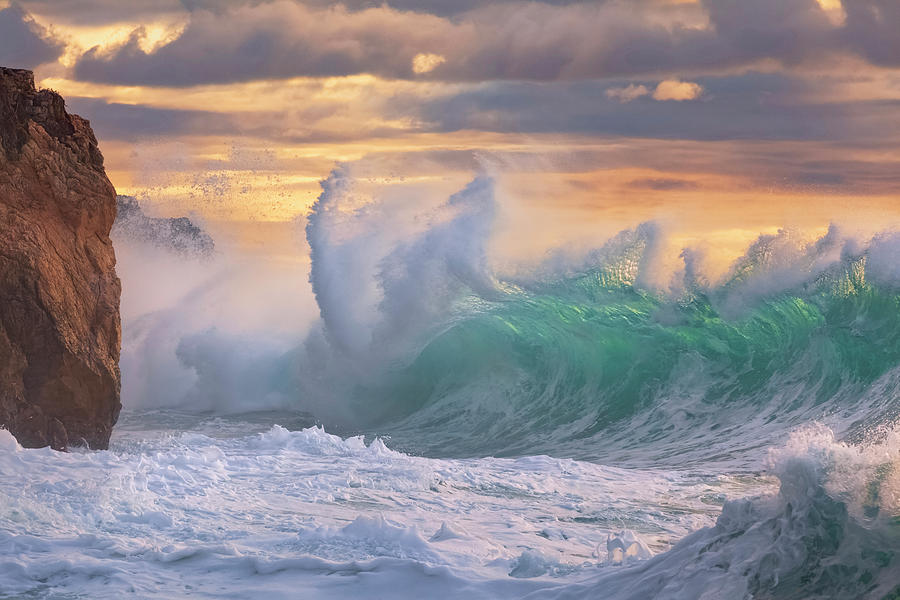
The only thing waves do transmit across the sea is energy. In reality, the water in waves doesn’t travel much at all. If one imagines water within a wave following this same pattern, it is easier to understand ocean waves as simply the outward manifestation of kinetic energy propagating through seawater. When a wave encounters a surface object, the object appears to lurch forward and upward with the wave, but then falls down and back in an orbital rotation as the wave continues by, ending up in the same position as before the wave came by. Waves are actually energy passing through the water, causing it to move in a circular motion. Though waves do cause the surface water to move, the idea that waves are travelling bodies of water is misleading.
Ocean waves storm series#
Looking out at the ocean, you often see a seemingly infinite series of waves, transporting water from one place to the next.
Ocean waves storm download#
Download larger version (mp4, 5.3 MB MB). Video courtesy of NOAA Ocean Exploration, 2021 North Atlantic Stepping Stones: New England and Corner Rise Seamounts.

As weather allowed, the team continued with mapping objectives, waiting it out until the next available dive day. During the 2021 North Atlantic Stepping Stones: New England and Corner Rise Seamounts expedition, 25-knot winds and sustained swells resulted in a cancelled dive. Waves in the wrong form can spell trouble for remotely operated vehicle operations. To view this video please enable JavaScript, and consider upgrading to a web browser that supports HTML5 video Diversity, Equity, Inclusion, and Accessibility.In turn, broken corals are more susceptible to disease and death. However, hurricanes can also rip apart corals and dump huge amounts of ocean sediment on them, killing the coral, Smith said. What's more, some corals depend on high-energy waves to break them up and spread their fragments afar, where they can "take root" in a new area and grow into a new reef, Jennifer Koss, director of NOAA's Coral Reef Conservation Program, told Live Science. (Smith managed to evacuate from the Virgin Islands before Hurricane Irma struck this week.) As mentioned, hurricanes cool the water in their wake, which is welcome news for coral in danger of higher ocean temperatures, said Tyler Smith, an associate research professor of marine science at the University of the Virgin Islands. Hurricanes are a mixed bag for coral, which can protect coastlines from waves and storms, according to the National Oceanic and Atmospheric Administration (NOAA).Īs the planet, and oceans, warm, more corals are turning white and dying - a process known as bleaching. Not only because they get smashed around by the waves but because there's less dissolved oxygen in the water and rapid salinity changes as the ocean's deep and shallow waters mix, McNoldy wrote. īut slower swimming or territorial fish, as well as crabs, sea turtles and oysters, typically fare poorly during hurricanes. "They're pulling up deep water that's usually colder than the surface water, which is warmed by the sun." Keep swimmingĭuring a hurricane, fast-swimming fish, such as sharks, usually escape harm, as they can detect small pressure changes in the water, prompting them to swim deeper or farther away, according to a blog written by Brian McNoldy, a senior research associate at the Rosenstiel School of Marine and Atmospheric Science at the University of Miami. "When hurricanes propagate across the ocean, they tend to leave a cooler trail of water in their wake," Storlazzi said. The hurricane's powerful winds can also mix the ocean's cold, deep waters with warmer, shallow waters. This extremely fast horizontal movement within the ocean can kick up sediment and even move large objects - "you always hear about old sunken ships being unburied in storms because you have very strong horizontal motions," Storlazzi said. And those cause a lot of stress, or force imparted on the seabed." "Instead of being circular, they're very horizontal, just back and forth. "When those orbital motions near the bottom, they can't go through the seabed, so they tend to flatten out," Storlazzi said. However, if there is a very long wave length, then this circular moving water can reach all the way down to the continental shelf, which can be hundreds of feet below the water's surface, he said.

"If the distance between subsequent wave crests is 100 meters, then below about 50 meters you won't have any of that orbit motion," Storlazzi told Live Science. Scientists have learned that these stacked-hoop disturbances - that is, water moving in a circular motion, setting off another circular orbit below it - are only half the distance in length from one wave peak to the next.


 0 kommentar(er)
0 kommentar(er)
